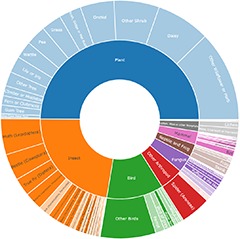Insects
A guide to Australian insect families (from CSIRO) can be found at:
http://anic.ento.csiro.au/insectfamilies/
Daley, A. & Ellingsen, K., 2012. Insects of Tasmania: An online field guide
A useful introduction to Insects, visit:
http://australianmuseum.net.au/uploads/documents/9362/invertebrate_guide.pdf
A diagram of Insect morphology illustrating terminology with legend of body parts:
https://en.wikipedia.org/wiki/Insect_morphology#/media/File:Insect_anatomy_diagram.svg
A diagram of an insect illustrating terminology based on a worker ant, see:
https://en.wikipedia.org/wiki/Gaster_(insect_anatomy)#/media/File:Scheme_ant_worker_anatomy-en.svg
Photographing insects
There are two main ways to photograph insects with a camera: using a macro close-up lens or a zoom lens. If the insect tolerates your getting very close, then you can use the macro lens. For example, some moths will remain quite still when approached, believing they are camouflaged and invisible. However, many insects, especially those that can fly, will move away when you approach. This is especially true for insects like butterflies and dragonflies. So a good zoom lens is very useful for photographing many insects. If you are using a smartphone, then use a macro lens or a macro attachment. E.g. OlloClip for iPhone. If you want to have an insect identified to species then clear photographs are usually needed because minute parts of the anatomy may need to be checked. It is valuable to take several photos from various angles so that these anatomical details can be seen. Many insects are have particular plants that they feed on, and they can be identified more easily when the associated plant is known. So if the insect is resting or feeding on a plant, take note of what the plant is or ensure that a photo shows the plant clearly.
Announcements
Hello NatureMaprs!Three new priority species lists of exotic freshwater and terrestrial invertebrates, and vertebrates in the ACT have been added to NatureMapr. Uploading records of these species to N...
Continue reading
NatureMapr now receives more records in NSW than ACT
NatureMapr Data Collector 6.2.1 update
Critical nature positive infrastructure update
IMPORTANT NatureMapr Data Collector 6.2.0 mobile app update
Discussion
Choreutis emplecta
I’ve tentatively left both names in (but wrote “formerly” next to Rhytiphora albocincta), but I’m not in the know with revisions & thought you might be able to confirm this is correct for me (or point me in the right direction on how to find out). Hoping you can help, thanks so much💚
Rhytiphora albocincta
Aglaosoma variegata
Calomela juncta
Calomela juncta
Significant sightings
- Sphaeniscus atilius at Melba, ACT
- Sardia rostrata at Melba, ACT
- Austromiris nigronasutus at Melba, ACT
- Keyacris scurra at Borough, NSW
- Heide amiculi at Borough, NSW
- Nola tornotis at Bulli, NSW
- Heide amiculi at Tallong, NSW
- Microconops (genus) at Campbell, ACT
- Cardiochilinae sp. (subfamily) at Hall, ACT
- Earias smaragdina at Rosedale, NSW
Recent activity
Heteronympha penelope at Gunning, NSW
Heteronympha penelope at Gunning, NSW
Heteronympha penelope at Gunning, NSW
Heteronympha penelope at Gunning, NSW
Aglaosoma variegata at Moruya, NSW
Platybrachys sp. (genus) at Watson, ACT
Lamprolina (genus) at Balgowlah Heights, NSW
Rhytiphora collaris (formerly Rhytiphora albocincta)
Top contributors
- kasiaaus 8.8K
- AlisonMilton 8.7K
- Hejor1 7.8K
- ConBoekel 4.7K
- jb2602 4.6K
- trevorpreston 4.5K
- Harrisi 3.3K
- TimL 3.3K
- KylieWaldon 2.9K
- MatthewFrawley 2.9K
Top moderators
- MichaelMulvaney 20.6K
- donhe 16.9K
- ibaird 14.3K
- AlisonMilton 10.5K
- KimPullen 5.8K
- RogerF 5.7K
- SuziBond 5.6K
- HarveyPerkins 4.7K
- MichaelBedingfield 4.3K
- owenh 3.8K















































































































